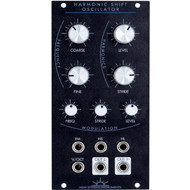Harmonic Shift Oscillator - New Systems Instruments
by Sam Chittenden
At first glance the Harmonic Shift Oscillator from New Systems Instruments comes across as a minimalist take on a complex oscillator [by today's standards]—as it seems anything but complex. With only four main control knobs, four inputs, two outputs, and three attenuators, and with two of the knobs for tuning [coarse and fine], that really leaves just two main controls. It looks a bit underwhelming when compared with some of the titanic oscillators that have been released lately, to the point where one one may be tempted to give it a cursory glance and move on, but that would be a big mistake. Big.
Out of the box the first thing to note about the HSO is the build quality. It feels great. A nice rugged aluminum faceplate and solid, silky smooth pots give the module a good sturdy feel. The graphics are crisp and informative, with an understated style that exudes a high-quality vibe. The four main knobs are divided between frequency control and harmonic control. The left two are simple Coarse and Fine tune, while the knobs on the right half are Level and Stride. Inputs, in addition to a V/Oct, are: FM [frequency modulation], HS [Harmonic Stride], and HL [Harmonic Level] with each input jack having a corresponding attenuator. The HSO has two outputs of the same waveform that are phase offset—0 degrees and 90 degrees—from each other.
Setting Level to 12 o'clock and proceeding with a casual twist of the Stride control from fully counter-clockwise to fully clockwise yields all manner of FM-like tones. From clean and sine-like to growling rumbles, detuned supersaw-like tones to glassy bells and there are some classic and fat tones to be found by playing around with the Stride control at a point near vertical. Adjust the Stride a little off the vertical position for just a touch of bite and keep the Level around 9 o'clock, throw in some modulation—attenuated to taste—on all three inputs [FM, HS, HL] and you’ve arrived in sweet spot city. Adding a little reverb on the end I lost two hours just listening to the HSO play arpeggiations from the Keystep Pro. There are some great bass tones to be found as well in the HSO and the straightforward controls make it easy to dial in the right amount of harmonics to sit nicely in a patch.
There is a lot of tonal territory to be explored over the full range of the Level and Stride controls and a lot of spaces to discover in the relationship between those two controls. Subtlety rules, and small changes can lead to wildly different tones. Needless to say the HSO loves modulation and the onboard attenuation is key to taming your external signals for interesting and satisfying results.
I really enjoyed the uncomplicated control approach to the HSO. It is a simple interface, but that simplicity is just an abstraction layer that allows for a very intuitive interface—one that makes short work of the additive style of synthesis—not that the HSO doesn't sound great when run through a filter or two, it does. Despite the math-y underpinnings [see the manual], the HSO is intuitive and inviting in the best possible way and that frees up some brain cells for other aspects of your music making. Just plug it in, turn some knobs, and surprise yourself by getting lost in the gorgeous tones that emanate from within.
12HP +12V 80mA -12V 75mA
Price: $355


